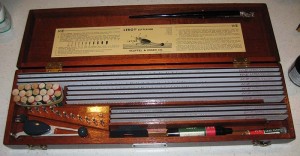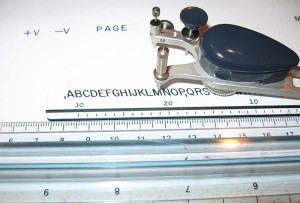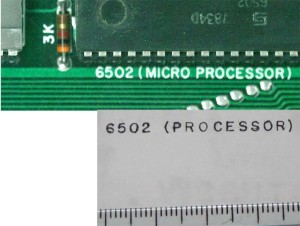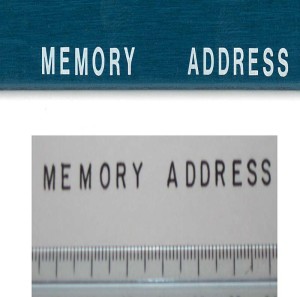I recently received an email that indicated that the Apple 1 was most likely lettered with the Leroy lettering. That email has resulted in a lot of research and exploration of exactly what is Leroy lettering and was it really used for lettering the Apple 1 PCB.
First thing to figure out is what is the Leroy lettering system? It is a system to mechanically create lettering that was intended to generate legible lettering on a drafting table. Engineering documents, maps, architectural drawings and the like were the primary applications.
Here is an image of a K&E Leroy lettering set.
It’s easier to show how it works, than describe it. Here is an image of one set up to make a capital M. The scribe follows the letting in the ruler like jig and ink in the “pen” writes a pretty exact copy of that letter. There are a series of jigs for different sized letters. The scribe tool can be adjust to make the letters slanted in an italic type fashion.
So how do we determine whether this system was used to make the lettering for the Apple 1. The easiest way is to compare the lettering on an actual Apple 1 with an example we know was made with Leroy lettering System.
You can see that the newly created Leroy lettering (bottom) is nearly a perfect match to the Apple 1 (top), so I think that we can be pretty confident that the Apple 1 lettering was made with the Leroy or very similar lettering system.
My next question is whether the SCELBI front bezel was also lettered with the Leroy system.
Though the lettering is very close, there are some differences in the leg on the “R” and the “A” looks a little different. Also the ends of the strokes on the letters have nice square edges, which would not occur in a Leroy lettered system.
Finally, follow this link to see what Wonder Woman comic books have in common with the Apple 1.





I don’t know what research you have done into this, but I don’t think the similarity in appearance alone is conclusive to the Apple 1 overlay text being produced on a Leroy system. The Apple 1 appears to use the Helvetica font (or at least a close variant). The shape of the numbers 1, 2, and 7 in particular is distinctive and characteristic of Helvetica (although some of the 1’s on the Apple 1 seem to differ to standard Helvetica, that might be explained by using an ‘I’ instead of a true ‘1’). I think the most that can be said is that the font used on the Leroy is at least very similar if not the same and that it is probably a Helvetica variant, which is not surprising as it was and still is a very popular printing font.
Another possibility is that Letraset dry-transfers were used for the overlay text. Looking at the photo in your blog I would almost bet money that the Scelbi front bezel text was produced using Letraset.
Hi Lionel,
The larger characters on the Apple 1 are not Leroy, but I’m convinced the smaller stuff is. Transfer letters would have crisper ends, without the rounded characteristic of the end of a pen drawn line. Stay tuned for more posts on my investigations into the larger lettering.
I believe that it may have been my email that sparked this research. The K&E Leroy machine was very widely used in this period when boards were hand taped.
If you look at the Q1 label on the Apple 1 board, we see that the number 1 has the “hat” on it whereas every other “1” on the board was substituted for a “I”.
Also the crossed zero’s on the ram 0 location – I believe that these may even be the diameter symbol used in engineering drafting, though could also have been manually crossed.
I found a very close truetype font called Planscribe which is based on the Leroy font, though the “1” does not have the “hat”.
As for the font used on the copper layer – particularly the Apple 1 text – this is very likely to be letraset.
Correction to my previous post – the “1” with the hat is also used for J1 label and also the video and power connector pin 1.
I think most of the other ones are substituted for “I” – there may be some other exceptions on labels that cant be seen (under the large caps for example).
Pingback: More Apple 1 Fonts « Mike's Hobby Blog